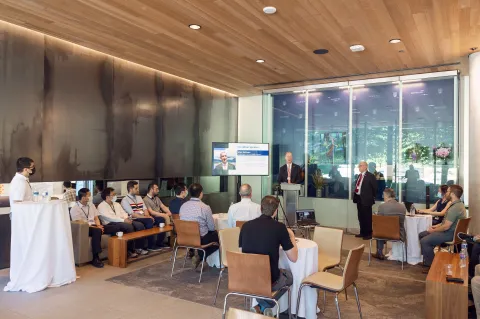UBC Engineering and Fraunhofer aim to digitally transform aerospace, automotive manufacturing
The Internet of Things and big data are revolutionizing how the manufacturing industry operates. A freshly launched research collaboration between UBC Faculty of Applied Science and two Fraunhofer Institutes will provide new digital offerings to support the industry’s transformation.

Aerospace, automotive and machine tools manufacturing can look forward to new digital services that promise to make their operations more efficient and productive.
Leading researchers from UBC Faculty of Applied Science, Fraunhofer Institute for Experimental Software Engineering (IESE), and Fraunhofer Institute for Machine Tools and Forming Technology (IWU) came together on July 27 for a reception and lab tour to celebrate a new research collaboration targeting the digital transformation of the manufacturing industry.
The initial two-year pilot aims to pool research expertise from the three institutions to create digital twins for manufacturers in aerospace, automotive and machine tools.
A digital twin uses Internet of Things sensors to track data a machine, process or factory in the real world and replicate this in a virtual environment.
For manufacturers reliant on manual operations, the level of real-time data and insights that digital twins offer is game-changing—particularly in the face of sudden, deeply disruptive events like the COVID-19 pandemic.
“Compared to the turbulent world around us, international co-operation in science and technology is an anchor in sometimes troubled waters,” said Marc Eichhorn, Consulate General of the Federal Republic of Germany. The UBC-Fraunhofer Collaboration on Industrial Digital Transformation (C-IDT) represents a “milestone of scientific collaboration and our commitment for the future.”
Canada and Germany enjoy a long history of science and technology cooperation, with more than 1,000 joint research projects over the last 50 years. The UBC-Fraunhofer C-IDT is only the latest project in that history, building upon a decade-long partnership between UBC and Fraunhofer.
Such collaboration not only allows for economic opportunities—Germany is Canada’s largest export market in the EU, with two-way trade worth approximately $26 billion in 2021—but also opens the door to more quickly address critical challenges like climate change and the COVID-19 pandemic.
“This type of collaboration is not just an economic opportunity and a great platform for scientific discovery,” said Dr. Walter Mérida, Associate Dean for Research and Industry Partnerships, UBC Faculty of Applied Science. “In my opinion, it has become now a necessity, given the short timeframe that we have with the challenges that we are experiencing. We don't have 100 years to change our energy systems without accelerating the innovation required to do that.”
Digital innovations are driving an incredible transformation of the manufacturing industry—so much so, that this transformation is considered the fourth industrial revolution (Industry 4.0).
Dr. Peter Liggesmeyer, Director of Fraunhofer IESE, spoke about the value in combining the three partners’ expertise in Industry 4.0 software, machine tools, and thermal influences and tool degradation to create digital twins that will contribute to that transformation. Together, they will be able “to improve offers for industry partners in North America and Europe.”
Dr. Steffen Ihlenfeldt, Director of Fraunhofer IWU, painted a picture about the “factory of the future”: that manufacturing is moving towards: one which uses local resources, has co-creation processes, is carbon-negative, integrated in the urban environment and allows for hybrid work.

Such collaboration not only allows for economic opportunities but also opens the door to more quickly address critical challenges like climate change and the COVID-19 pandemic. Image by Martin Dee Photography.
The UBC-Fraunhofer C-IDT’s work on digital twins represents an early step towards this vision.
“One of the key aspects of this project is to transfer our knowledge to industry,” said Dr. Yusuf Altintas, Director of the Manufacturing Automation Laboratory at UBC. Digital twins will help manufacturers better monitor their machines and processes. They also allow manufacturers to model changes in a virtual environment before real-world implementation, reducing risk and cost, and enabling safer, more precise operations.
While the pilot targets aerospace, automotive and machine tools manufacturing—industries with eye-watering operating costs and no room for error—Dr. Altintas reiterated the group’s shared hope to expand to other fields. These possibilities include important BC industries such as timber, food, shipbuilding, healthcare (potentially through the UBC School of Biomedical Engineering), mining and smart farming.
The UBC-Fraunhofer C-IDT is open to long-term collaboration with research experts across UBC’s campus, other universities and industry partners. If you are interested in learning more about the collaboration, please contact the UBC APSC Research and Partnership team at C-IDT@apsc.ubc.ca.


